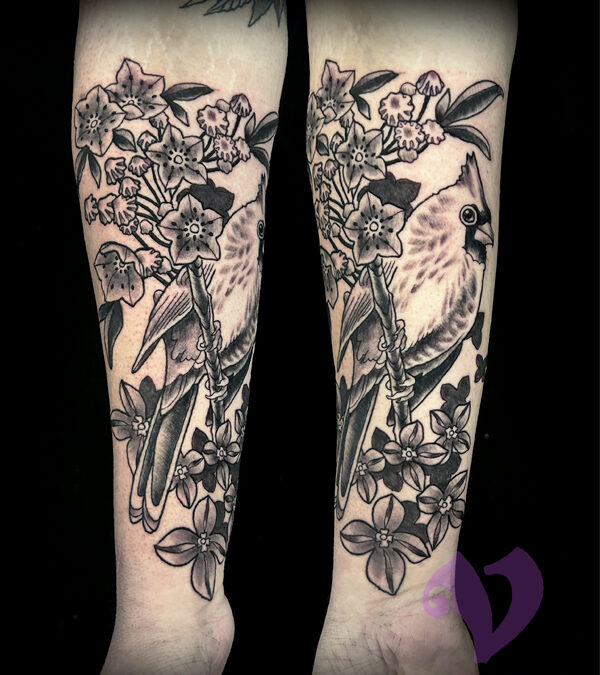This Cardinal bird tattoo has been done in an illustrative tattoo style.
The client wanted it perched on a branch.
Also , the client preferred it done in Black and grey.
There is a good balance of dark, light and midtones to make this design read well.
Are you looking for a Cardinal tattoo, bird or flower type tattoo?
Visions has got you covered!
Go to our Tattoo Request Form to get your tattoo project started!!
About Cardinals
The cardinal is most responsible for getting people to open a field guide more than any other bird.
Cardinals are a perfect combination of familiarity, conspicuousness, and style.
They have a shade of red you simply cannot take your eyes off.
Even the brown females sport a sharp crest and warm red accents.
Cardinals are not known to migrate, and they do not molt into a dull plumage.
Therefore, they are still breathtaking in winter’s snowy backyards.
In summer, their sweet whistles are one of the first sounds of the morning.
Their family consists of Cardinals, Grossbeaks and Buntings.
Cardinals hop through low branches and forage on or near the ground.
In addition, they commonly sing and preen from a high branch of a shrub.
The distinctive crest can be raised and pointed when agitated or lowered and barely visible while resting.
You typically see cardinals moving around in pairs during the breeding season.
In fall and winter they form large flocks of up to several dozen birds.
As a result, foregoing their territorial ways and congregating together.
A group of cardinals looking for food collectively is far more successful than a single cardinal or pair.
These flocks can be called a college, deck, radiance, or Vatican of cardinals.
During foraging, young birds give way to adults and females tend to give way to males.
Cardinals forage with other species, including dark-eyed Juncos, white-throated sparrows, tufted titmice, and goldfinches.
They fly somewhat reluctantly on their short, round wings, taking short trips between thickets while foraging.
Pairs may stay together throughout winter, with up to 20 percent of pairs splitting up by the next season.
